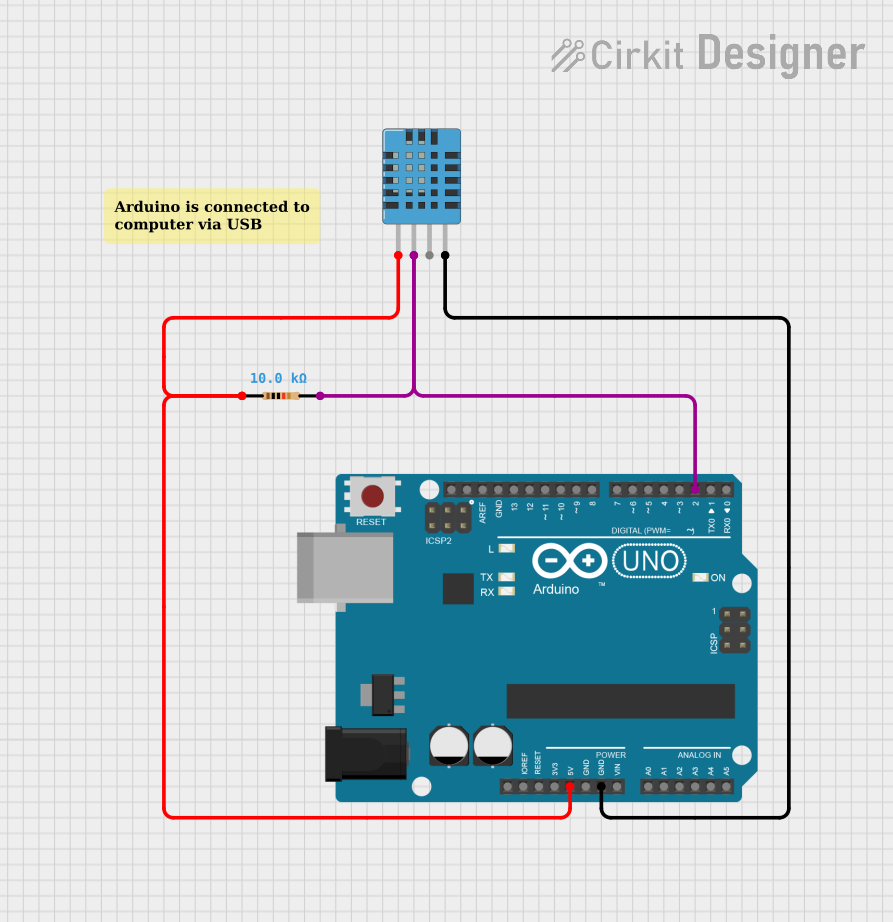
Cirkit Designer
Your all-in-one circuit design IDE
Home /
Project Documentation
Arduino UNO with DHT11 Temperature and Humidity Sensor

Circuit Documentation
Summary
This document provides a detailed overview of a circuit designed to collect temperature and humidity measurements using a DHT11 Humidity and Temperature Sensor interfaced with an Arduino UNO microcontroller. The circuit includes a pull-up resistor for the data line of the sensor. The Arduino UNO is programmed to read the sensor data and output the measurements to the serial monitor.
Component List
DHT11 Humidity and Temperature Sensor
- Description: A sensor that measures ambient temperature and humidity.
- Pins: VDD (Power Supply), DATA (Data Output), NULL (No Connection), GND (Ground).
Arduino UNO
- Description: A microcontroller board based on the ATmega328P.
- Pins: Various digital and analog I/O pins, power supply pins, and communication interface pins.
Resistor
- Description: A passive two-terminal electrical component that implements electrical resistance as a circuit element.
- Value: 10,000 Ohms (10kΩ).
Comment
- Description: A placeholder for additional notes or comments within the circuit design.
Wiring Details
DHT11 Humidity and Temperature Sensor
- VDD: Connected to the 5V output of the Arduino UNO.
- DATA: Connected to digital pin D2 of the Arduino UNO through a 10kΩ pull-up resistor.
- GND: Connected to the ground (GND) pin of the Arduino UNO.
Arduino UNO
- 5V: Provides power to the DHT11 sensor.
- D2: Receives data from the DHT11 sensor.
- GND: Common ground for the circuit.
Resistor (10kΩ)
- Pin1: Connected to the 5V output of the Arduino UNO.
- Pin2: Connected to the DATA pin of the DHT11 sensor and digital pin D2 of the Arduino UNO.
Documented Code
Arduino Sketch (sketch.ino)
/**
* This example demonstrates how to collect temperature and humidity measurements
* from the Adafruit DHT11 sensor. Measurements are printed out to the serial monitor.
*
* - Make sure to first install the following libraries through the Arduino Library Manager:
* - DHT Sensor Library (by Adafruit)
* - Adafruit Unified Sensor (by Adafruit)
* - When you open the serial monitor to view measurements from the DHT11, make sure
* that you select 9600 baud so that the serial monitor can receive data from the Arduino.
*
* This example was originally written by Adafruit Industries LLC.
*/
#include <Adafruit_Sensor.h>
#include <DHT.h>
#include <DHT_U.h>
#define DHTPIN 2 // Digital pin connected to the DHT sensor
// Uncomment the type of sensor in use:
#define DHTTYPE DHT11 // DHT 11
DHT_Unified dht(DHTPIN, DHTTYPE);
uint32_t delayMS;
void setup() {
Serial.begin(9600);
// Initialize device.
dht.begin();
Serial.println(F("DHTxx Unified Sensor Example"));
// Print temperature sensor details.
sensor_t sensor;
dht.temperature().getSensor(&sensor);
Serial.println(F("------------------------------------"));
Serial.println(F("Temperature Sensor"));
Serial.print (F("Sensor Type: ")); Serial.println(sensor.name);
Serial.print (F("Driver Ver: ")); Serial.println(sensor.version);
Serial.print (F("Unique ID: ")); Serial.println(sensor.sensor_id);
Serial.print (F("Max Value: ")); Serial.print(sensor.max_value); Serial.println(F("°C"));
Serial.print (F("Min Value: ")); Serial.print(sensor.min_value); Serial.println(F("°C"));
Serial.print (F("Resolution: ")); Serial.print(sensor.resolution); Serial.println(F("°C"));
Serial.println(F("------------------------------------"));
// Print humidity sensor details.
dht.humidity().getSensor(&sensor);
Serial.println(F("Humidity Sensor"));
Serial.print (F("Sensor Type: ")); Serial.println(sensor.name);
Serial.print (F("Driver Ver: ")); Serial.println(sensor.version);
Serial.print (F("Unique ID: ")); Serial.println(sensor.sensor_id);
Serial.print (F("Max Value: ")); Serial.print(sensor.max_value); Serial.println(F("%"));
Serial.print (F("Min Value: ")); Serial.print(sensor.min_value); Serial.println(F("%"));
Serial.print (F("Resolution: ")); Serial.print(sensor.resolution); Serial.println(F("%"));
Serial.println(F("------------------------------------"));
// Set delay between sensor readings based on sensor details.
delayMS = sensor.min_delay / 1000;
}
void loop() {
// Delay between measurements.
delay(delayMS);
// Get temperature event and print its value.
sensors_event_t event;
dht.temperature().getEvent(&event);
if (isnan(event.temperature)) {
Serial.println(F("Error reading temperature!"));
}
else {
Serial.print(F("Temperature: "));
Serial.print(event.temperature);
Serial.println(F("°C"));
}
// Get humidity event and print its value.
dht.humidity().getEvent(&event);
if (isnan(event.relative_humidity)) {
Serial.println(F("Error reading humidity!"));
}
else {
Serial.print(F("Humidity: "));
Serial.print(event.relative_humidity);
Serial.println(F("%"));
}
}
This code is responsible for initializing the DHT11 sensor, reading temperature and humidity data, and printing the results to the serial monitor. The sensor is connected to digital pin 2 of the Arduino UNO. The code includes detailed comments and instructions for setting up the sensor and interpreting the output.